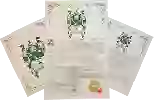
Winery FDLCôtes-du-Rhône
In the mouth this red wine is a .
This wine generally goes well with beef, game (deer, venison) or lamb.
Taste structure of the Côtes-du-Rhône from the Winery FDL
Light | Bold | |
Smooth | Tannic | |
Dry | Sweet | |
Soft | Acidic |
In the mouth the Côtes-du-Rhône of Winery FDL in the region of Rhone Valley is a .
Wine flavors and olphactive analysis
Food and wine pairings with Côtes-du-Rhône
Pairings that work perfectly with Côtes-du-Rhône
Original food and wine pairings with Côtes-du-Rhône
The Côtes-du-Rhône of Winery FDL matches generally quite well with dishes of beef, lamb or game (deer, venison) such as recipes of roast beef casserole, gypsy sauce or auvergne potée.
Details and technical informations about Winery FDL's Côtes-du-Rhône.
Discover the grape variety: Frontenac
A cross between Landot 4511 and Vitis Riparia 89 (very resistant to cold) obtained in 1978 at the University of Minnesota (United States) and propagated from 1996. It can also be found in Canada (Quebec, Ontario, etc.), in Lithuania, etc. In France, it is practically unknown. Note that the white and grey Frontenac are derived from mutations of the black, encountered and isolated in 2003 for the grey and in September 2005 for the white. - Synonymy: MN 1047 (for all the grape variety synonyms, click here!).
Last vintages of this wine
The best vintages of Côtes-du-Rhône from Winery FDL are 2016, 2015
Informations about the Winery FDL
The Winery FDL is one of of the world's greatest estates. It offers 94 wines for sale in the of Côtes-du-Rhône to come and discover on site or to buy online.
The wine region of Côtes-du-Rhône
The wine region of Côtes-du-Rhône is located in the region of Rhône méridional of Rhone Valley of France. Wineries and vineyards like the Château de Beaucastel or the Chateau de Fonsalette produce mainly wines red, white and pink. The most planted grape varieties in the region of Côtes-du-Rhône are Mourvèdre, Viognier and Marsanne, they are then used in wines in blends or as a single variety. On the nose of Côtes-du-Rhône often reveals types of flavors of pineapple, red plum or sour cherry and sometimes also flavors of truffle, juniper or clove.
The wine region of Rhone Valley
The Rhone Valley is a key wine-producing region in Southeastern France. It follows the North-south course of the Rhône for nearly 240 km, from Lyon to the Rhône delta (Bouches-du-Rhône), near the Mediterranean coast. The Length of the valley means that Rhône wines are the product of a wide variety of soil types and mesoclimates. The viticultural areas of the region cover such a distance that there is a widely accepted division between its northern and southern parts.
The word of the wine: Pitting (acetic)
Synonymous with acescence.














